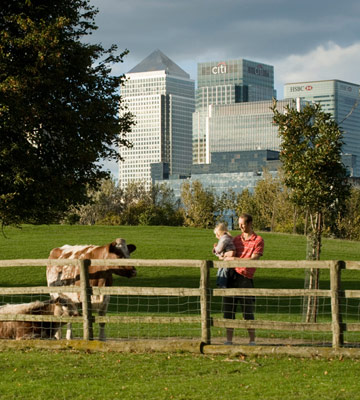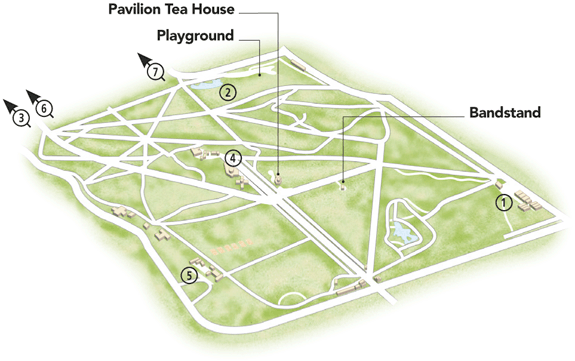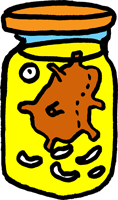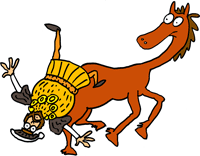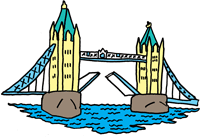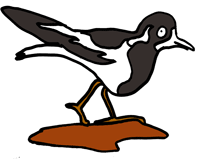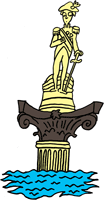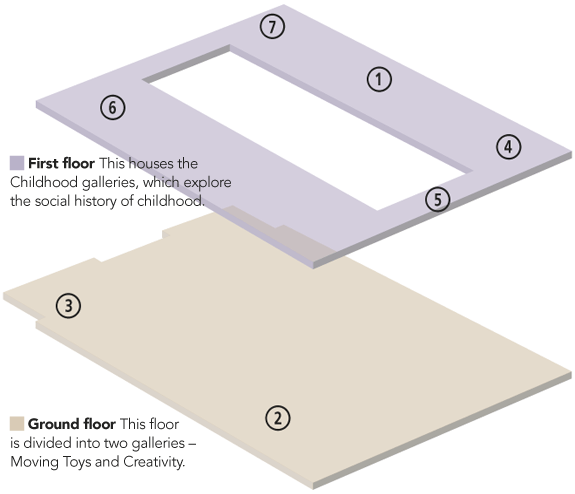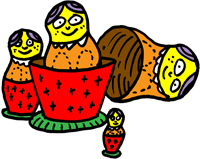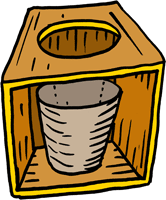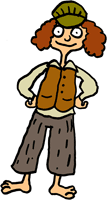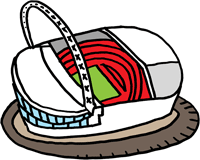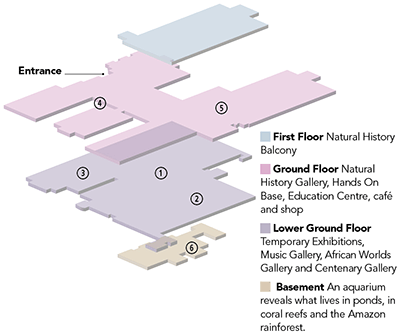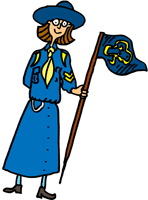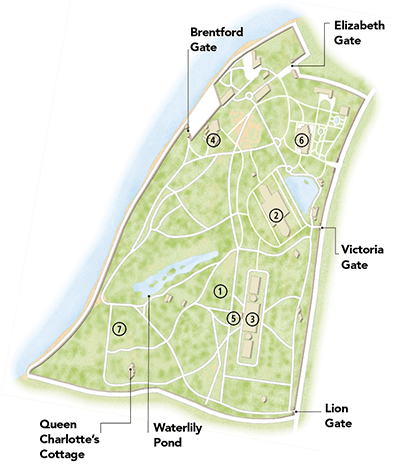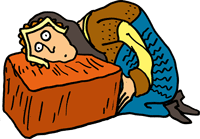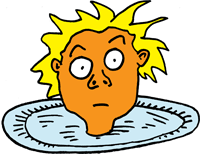The Best of Beyond the City Centre
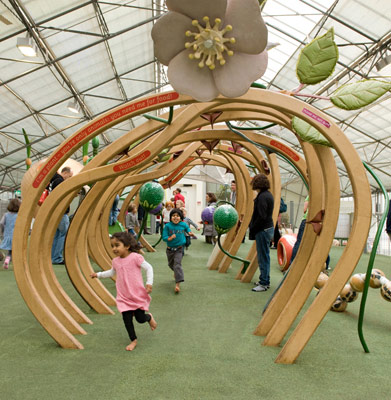
The Climbers and Creepers indoor playground at Kew Gardens
When it comes to visitor attractions, London’s riches extend far beyond the Tower of London, Buckingham Palace and Regent’s Park. Families who venture out from the centre will be richly rewarded, whether they go east to hip Hoxton, west into well-to-do Richmond and Kew, north to the pleasure grounds of Hampstead Heath or south to the splendours of Greenwich. Here are some itineraries that will help you pick out the plums.
A Greenwich weekend
If Greenwich were outside London, it would vie with Windsor, Oxford and Bath. There is so much to see here by the Thames. An exciting way to arrive is on the Docklands Light Railway (DLR), gliding through the skyscrapers of Canary Wharf. Hop off for the
Museum of London Docklands, where there’s a programme of events every Saturday. Carry on to Greenwich for lunch at
Discover Greenwich, then ramble through the
Old Royal Naval College and visit the
Cutty Sark.
On Sunday, pick up a picnic at
Greenwich Market and head for Greenwich Park. When its playground and pedal boats pall, dip into the free Discover Sundays kids’ programme at the
National Maritime Museum. For a star-studded finish, book family tickets for a blast into the Sky Tonight at the
Royal Observatory planetarium.
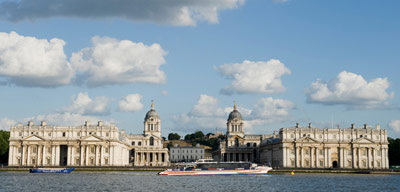
The Old Royal Naval College, Greenwich, designed by Sir Christopher Wren
Life out east
Beyond the pie-and-mash cliché, East London offers a rich mix of multicultural influences and terrific places to see. The starting point for families is the
V&A Museum of Childhood at Bethnal Green – parents can browse the vintage toys while their kids go nuts in play zones scattered about the building.
Just one Tube stop further east, in Mile End, is the
Ragged School Museum, offering an eye-opening Victorian classroom experience; while to the west, the
Geffrye Museum is all historical interiors and family action. Get to the Geffrye by bus (26, 48 or 55), or on foot via
Weavers Fields Adventure Playground (see
Letting Off Steam) and
Hackney City Farm. On a sunny day, however, most kids would opt for a bus ride north to London Fields (see
Letting Off Steam), with its sparkling outdoor lido. Spooky
Sutton House is also within easy reach.
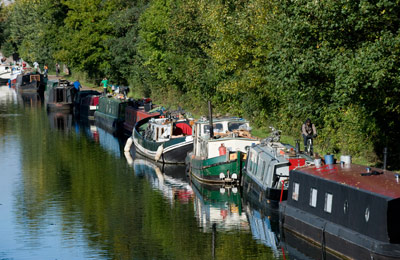
Narrowboats moored on the Hertford Union Canal, in Hackney’s Victoria Park
Gods and monsters
The
Horniman Museum, a mish-mash of macabre masks and mad musical instruments – is the kind of place that turns kids on to museum-going. It’s easy to fill a whole day here: activities include watching the honey bees and harvest mice in the Nature Base and the lively object-handling sessions every weekend afternoon. The museum is free, and nearby
Dulwich Park, with its boats, bicycles and café, is great for a lunchtime breather.
The Horniman also combines well with
Crystal Palace Park, a 30-minute bus ride south (176 or 197). It is full of Victorian character, with Punch & Judy shows in summer, spooky statues left over from Joseph Paxton’s Crystal Palace, and the unmissable Dinosaur Court, 30 life-size monsters beside a lake.
Wilderness diary
Yes, metropolitan London does have wilderness, albeit in child-size chunks. To find some, head southwest, where a trio of natural oases offer year-round treats for wildlife-watchers.
Spring is a great time to visit the
London Wetland Centre in Barnes. Sand martins swoop in from sub-Saharan Africa, Easter is full of fluffy ducklings, and there are walks to hear the dawn chorus. In summer, head to
Richmond Park, hiring bikes to see Isabella Plantation as the azaleas burst into flaming blooms. In October, the park’s red deer spar in their autumn rut. It’s never winter inside the steamy glasshouses at
Kew Gardens, and its Tropical Extravaganza fills February with spectacular orchid flowers.
< Beyond the City Centre
Greenwich and Around
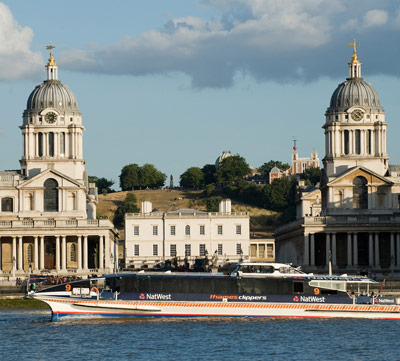
Thames river bus in front of the Old Royal Naval College, Greenwich
They don’t quite match Manhattan, but the shiny towers of Canary Wharf make a dramatic splash on London’s eastern horizon. Once the world’s largest port, this docklands quarter was reborn as a hive of business, entertainment and the high life. Arrive on the Docklands Light Railway (DLR) from Bank or Tower Gateway for a futuristic trip through the skyscrapers. Alight at West India Quay for the Museum of London Docklands; or at Mudchute for its city farm. Royal Greenwich, birthplace of Henry VIII, can be reached by DLR or river bus. Packed with museums and markets – all walkable – it’s an irresistible summer’s day out.
1. Greenwich
2. Old Royal Naval College
3. National Maritime Museum
4. Royal Observatory Greenwich
5. Museum of London Docklands
6. Mudchute Park and Farm
7. British Music Experience
8. Eltham Palace
9. Firepower Museum
10. Thames Barrier
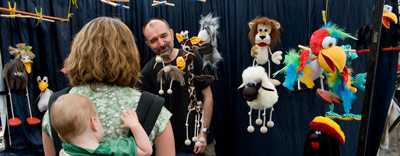
An array of colourful puppets on sale at Greenwich Market
1. Greenwich
Where east meets west
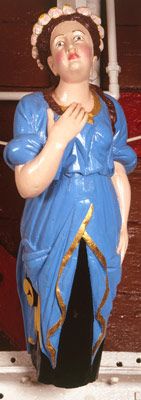
A ship’s figurehead
As well as periscopes and telescopes, pedaloes and playgrounds, roaming deer, jewelled lizards, exploding stars, the fastest Victorian tea clipper of its day, and Nelson’s bloody breeches, Greenwich is also the official home of Greenwich Mean Time in 1847. So there’s not a second to waste: climb to the top of the hill and see the glossy lawns of Greenwich Park spread out below, with space for squirrel-chasing, pedal-boating, and plenty of hands-on history.
Key Features
1. Wildlife Centre Hides and viewpoints overlook the park’s herd of deer, while the Secret Garden Wildlife Centre hosts monthly family open days.
2. Boating lake Boats and pedaloes are available from Easter to October.
3. Greenwich Market From Tuesday to Sunday, the market jumps with stalls selling food, vintage clothing and a variety of arts and crafts.
4. Royal Observatory Home of Greenwich Mean Time and the Prime Meridian of the World, The Royal Observatory is the official starting point for each new day and year.
5. Wernher Collection Enamelled skulls and an opal-encrusted lizard pendant shine among the paintings and porcelain collected by diamond magnate Julius Wernher (Sunday-Wednesday, www.english-heritage.org.uk).
6. Cutty Sark Built in 1869, this Victorian tea clipper was the fastest of its day. Following a six-year conservation project, it has been raised 3 m (10 ft), allowing visitors to walk beneath its copper hull and explore its upper decks.
7. Trafalgar Tavern This atmospheric old pub teetering on a prow of land above the Thames is Greenwich’s unofficial figurehead.

Left
Cutty sark Middle Trafalgar tavern Right Royal observatory
Kids’ Corner
What a view!
One Tree Hill, in Greenwich Park, has one of the best views in London. Climb to the top and see if you can tick off these famous landmarks …
- St Paul’s Cathedral
- Canary Wharf
- The Gherkin
- The London Eye
- Tower Bridge
- The O2
Get ready to tumble
It is said that Henry VIII liked to play ring-a-roses with Anne Boleyn on One Tree Hill, and 200 years ago it became a popular spot for “tumbling” – when ladies and gentlemen would roll down the hill for fun! Try this yourself – but don’t tell the grown-ups we suggested it!
Witch hunt
There’s a famous witch at Greenwich called Nannie. She’s on the Cutty Sark, the magnificent Victorian sailing ship berthed here. Nannie first appeared in a Robert Burns poem that tells how a man called Tam o’ Shanter finds some witches dancing in a churchyard. Nannie chases after him, but Tam escapes by riding his horse across the river – and, as you may know, witches can’t cross flowing water. If you visit the Cutty Sark, look out for Nannie. She is still holding the prize she captured during the chase. What is it?
2. Old Royal Naval College
Home for old sea dogs
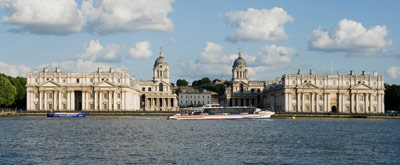
The symmetrical Thameside façade of the Old Royal Naval College
Set on riverside lawns, with the silver towers of Canary Wharf rising across the water, Sir Christopher Wren’s double-domed palace is the best collection of Baroque buildings in Britain. Except this wasn’t a palace, it was a residential home for injured soldiers. Queen Mary II commissioned the complex in the 1690s, and until 1869, seamen spent their days here drinking, gambling and dragging their wooden legs to the river and back.
Today, the college’s slick Discover Greenwich visitor centre introduces the place’s maritime history – it was the Royal Naval College from 1873–1998 – using lots of tactile gadgetry. There’s a dressing-up box, self-guided family trails and crafty children’s workshops in the school holidays. Daily guided tours specialize in the kind of horrible history that kids love, including the grisly story of how Horatio Nelson returned from the Battle of Trafalgar in 1805 – preserved inside a barrel of brandy. Nelson’s body lay in state in the Painted Hall, London’s answer to Rome’s Sistine Chapel, which must be the finest dining hall in Europe – the old sailors once ate their mutton and beans here. Tours also visit the College’s underground skittle alley, with its musket ball missiles – and don’t miss a peep into the quadrangle now occupied by Trinity Laban of Music, where tubas parp and pianos tinkle from every window.
Kids’ Corner
Hocus pocus
One of the strangest objects at Discover Greenwich is a “witch bottle”, buried near here 400 years ago. In Tudor times, people thought hiding a jar full of nasty stuff might ward off a witch’s curse. Which of these items do you think are not inside the bottle: bent pins, fingernail clippings, a leather heart, a newt’s eye, human urine, a frog’s toe, belly-button fluff.
3. National Maritime Museum
Dive into the depths of Britain’s nautical past
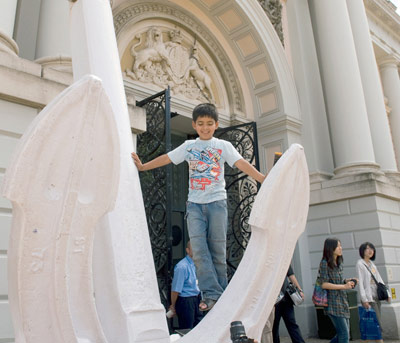
Playing on one of the huge anchors outside the National Maritime Museum
Bigger than the average cruise liner, the National Maritime Museum’s central hall – a shiny glass cube full of whirring propellers and winking lighthouses – makes an instant impact on children. Prize exhibits from five centuries of nautical history are here, including Prince Frederick’s gilded barge, which once propelled Georgian monarchs along the Thames. Upstairs are galleries devoted to explorers, cruise travel and the slave trade, while it’s all hands on deck on Level 2, where kids aged 5 to 85 get to hoist flags, load a cargo ship and even fire a cannon. Older children will love the simulation of a sea captain’s bridge, which challenges them to steer boats into port. The sea-themed family events schedule divides into sessions for under-5s (Tue) and over-5s (Sat) – both are catered for on Sundays. The museum’s Sammy Ofer wing hosts temporary exhibitions and is also home to a café and shop, along with a more upmarket restaurant serving contemporary British cuisine.
It is the museum’s artifacts that most capture the imagination, though: Admiral Nelson’s bloodstained breeches, cut from his body after Trafalgar; and the snow boots, part-chewed in hunger, from Sir John Franklin’s Northwest Passage expedition, lost in the ice in 1847. The adjoining Queen’s House, a pearlescent Palladian villa from 1614, shows off the museum’s nautical art collection, including Canaletto’s celebrated view of Greenwich from across the Thames.
Kids’ Corner
Trick a grown-up
Admiral Nelson famously damaged an eye while fighting in Corsica. Ask an adult which eye he wore his eye-patch on. Did they say the left? Wrong eye! Did they say the right? Right eye, but still the wrong answer! Nelson never wore an eye-patch.
Could you be the next Nelson?
4. Royal Observatory Greenwich
The world’s timekeeper
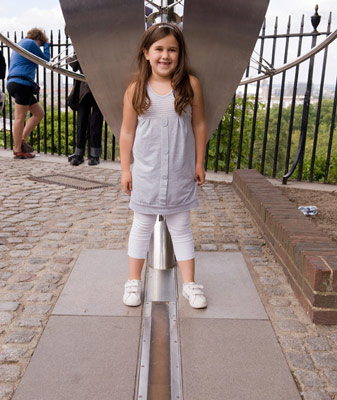
A favourite photo opportunity – astride the Prime Meridian
Dominating Greenwich Park’s skyline, the Royal Observatory is a Willy Wonka affair, with green onion domes and a red gobstopper on the roof. The gobstopper is actually the “time ball”, which drops daily at 1pm to signal the hour to passing ships. The world has been setting its clocks by Greenwich Mean Time since an international conference fixed the line of zero longitude here in 1884, making this the official starting point for each new day and year. Today, visitors queue to have a photo taken astride the Prime Meridian.
The observatory hosts a galaxy of exhibitions, from the intricate to the interplanetary. Watchmaker John Harrison’s grapplings with the longitude conundrum will confuse most adults, but the astronomy galleries are much more friendly to children, with a film evocation of the Big Bang and a 4.5 billion-year-old meteorite. In the Astronomy Explorers room kids can man the flight deck and send a virtual space probe to Venus. The most memorable part of the visit, though, is the Peter Harrison Planetarium: tilt back in an armchair and watch as worlds appear, stars detonate and universes collapse on the big screen above.
Kids’ Corner
Joust!
At low tide, head for the “beach” and hunt for bits of red brick left behind from King Henry VIII’s Greenwich Palace, which once stood here. In 1536 Henry had a jousting accident at Greenwich. Some experts think his injuries from it are what made him so bad-tempered. Four months later, he chopped off the head of Queen Anne Boleyn.
5. Museum of London Docklands
Sailors, slaves and swashbucklers
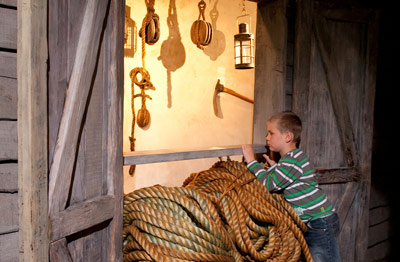
Checking out the nautical displays at the Museum of London Docklands
London’s best museum for children? Step forward the Museum of London Docklands which, not content with offering a terrific soft-play area for toddlers, runs weekly Mini Mudlarks sessions for gallery-goers under the age of 2. It shows just how hard the museum tries to engage families.
The museum is set within a Georgian sugar warehouse, built with the profits of the slave trade, and tells the 2,000-year story of wharfside London. Thanks to a series of galleries packed with models, movie clips and touch-screen fun, the place is surprisingly rewarding for children. They will be fascinated by a gibbet cage that was once used to dangle dead pirates above the Thames, and can explore the atmospheric alleyways of Sailortown, a realistic reconstruction of Victorian Wapping, complete with a noisy alehouse and a smelly wild animal emporium.
However, the dedicated children’s gallery, Mudlarks, is best saved till last, otherwise it will be impossible to get the children away from its banks of bashing, flashing gadgets and games. Here, they get to hoist cargoes, delve for archaeological finds and even build a scale model of Canary Wharf.
Visit on a Saturday, or during school holidays, when the museum’s family events programme shifts into top gear with a tumult of Caribbean dancing, cookery demonstrations and computer animation workshops.
Kids’ Corner
Quay questions
Try this Museum of London Docklands quiz…
-
How many arches did London Bridge have in 1440?
-
What did whaleboat captains draw in their journal when they killed a whale?
-
Which continent did trading ships import coffee from?
-
In which year was the slave trade banned in Britain?
-
Where would you go to buy rope in London Docklands?
Glorious mud
In Victorian London, “mudlarks” was the name given to poor children who hunted on the slimy banks of the Thames for things to sell. It was an unpleasant job – in those days, the river was awash with broken glass, toilet waste, even dead bodies!
6. Mudchute Park and Farm
Dally with Dalai the llama
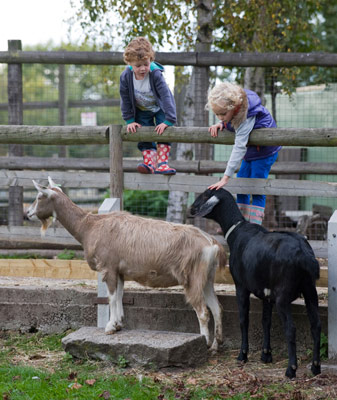
Friendly goats lining up for petting at Mudchute Park and Farm
It is one of the more surreal sights in London: a llama called Dalai trotting around his paddock, with the Canary Wharf skyscrapers behind. Mudchute is one of Europe’s largest city farms, home to every bleating, braying animal from a child’s colouring book – plus three llamas and a few rare breeds, too.
Arrive on the Docklands Light Railway (DLR) for a truly space-age journey along elevated tracks in driverless trains – it’s best experienced in the front carriage. The farm’s noisy donkeys, Dizzy and Snowflake, send a rallying call to visitors walking in from Mudchute or Crossharbour stations, and once inside, there are pastures and parkland to explore, riding stables and a courtyard with exotic aviaries and cuddly rabbits and guinea pigs. Stroking is actively encouraged, just ask a friendly farmhand.
Kids’ Corner
A pig’s tale
Have you heard the story of the Tamworth Two? They were a pair of Tamworth pigs, like those at Mudchute Farm, who got out of their truck on the way to market. The brave porkers made a run for it, crossing a river and hiding out in some woods. Newspapers named them Butch and Sundance, after two famous outlaws. They were eventually captured – but by then they were celebrities, so instead of becoming bacon, they lived happily ever after at an animal sanctuary. Oink!
7. British Music Experience
Pop star for a day
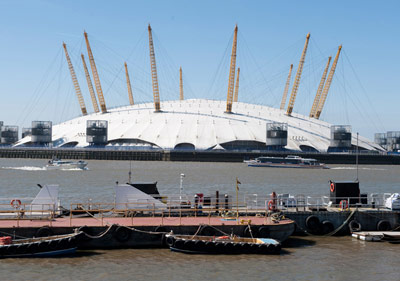
The iconic white dome of London’s O2, viewed from the river
This tribute to British pop has a suitably rock’n’roll setting, under the huge white dome of the O2. To kids, it looks like a flying saucer parked beside the Thames, and skimming there by riverbus from the centre of town is a thrill in itself.
Taking its place in the O2’s “entertainment avenue”, alongside concert halls, a multiplex cinema and restaurants, the Music Experience spins through 60 years of pop history with the aid of video screens, sound stations and memorabilia. Younger children will be hugely impressed by all the digital wizardry – including “Smartickets” that allow visitors to tag film and audio clips to replay online at home. Giggles are guaranteed in the Dance the Decades booth, offering dance-floor favourites for kids (and adults) to groove along with, while the Gibson Interactive Studio has video guitar lessons from rock legends and the chance to belt out tracks by Girls Aloud.
Located a short walk from this is the Emirates Air Line, a Thames Cable Car that opened in 2012 and links Docklands with Greenwich Peninsula. This is a fun way for kids to cross the river and get a stunning view in the process.
8. Eltham Palace
Art Deco dream house
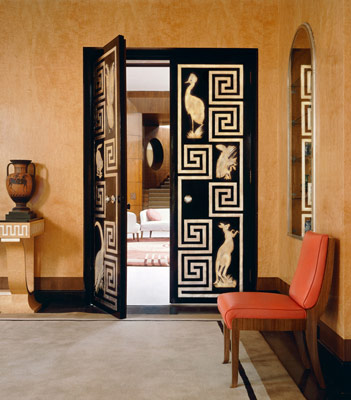
The impressive Art Deco interior of Eltham Palace
With its gold-plated bathroom, self-vacuuming floors and lemur’s bedroom, a tour of Eltham Palace is anything but humdrum. Squatting improbably in one of South London’s suburbs, the royal palace began life in 1305 as the grand, moated manor of King Edward II, and its 15th-century Great Hall and Tudor bridge look much as they did when the young Henry VIII played in the grounds. Step inside the adjoining house, though, and there’s an even bigger surprise – a decadent Art Deco interior from the 1930s, put together with enormous panache by society high-rollers Stephen and Virginia Courtauld.
The Courtaulds lavished their textile fortune on the house, and the whole place screams glamour: the dining room has a shimmering aluminium ceiling and pink leather chairs; Virginia’s vaulted bathroom has an onyx tub and gold taps. A built-in “hi-fi” supplied the jazz soundtrack for their Hollywood-style house parties. Children will be especially captivated by the deluxe living quarters of Mah-Jongg, the couple’s pet lemur, who enjoyed such luxuries as central heating and hand-painted wallpaper. Mah-Jongg features heavily in Eltham’s activity sheets for kids, and the palace’s events programme typically includes Tudor jousting and Art Deco fairs.
Kids’ Corner
Jungle VIP
Stephen and Virginia Courtauld kept lots of pets at Eltham Palace, including Caesar the Great Dane, who was fond of stealing sausages from the local butcher. But their favourite was Mah-Jongg, the lemur they bought from Harrods in 1923. Mah-Jongg sometimes bit the Courtaulds’ staff, but they treated him like a child. Look out for him in a home movie shown every day at the palace.
9. Firepower Museum
Battle stations everyone!
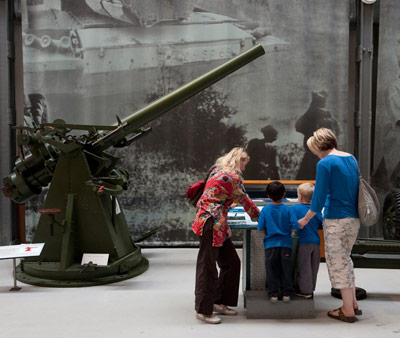
Explore military weaponry throughout history at the Firepower Museum
If only all wars were fought with sponge balls. Hopefully, that’s the message kids will take away from Firepower, aka the Royal Artillery Museum. Housed in warehouses at Woolwich Arsenal, once England’s largest ordnance factory, this is a full-bore celebration of military weaponry, and its interactive Camo Zone squarely targets young children. Prepare to do battle on the sponge-ball firing range, chase along the bungee run and fight it out with radio-controlled tanks – it’s great fun for all. Soldiers in combat gear are on hand to supervise.
Elsewhere, the Gunnery Hall bristles with vintage anti-aircraft guns and missile launchers, and visitors can attempt touch-screen missions – shoot down a bomber, or destroy a tank. The History Gallery takes visitors through the story of armaments, all the way “from catapult to rocket”, while Fields of Fire is hopefully the closest kids will ever come to being in battle – four big-screens flash archive footage of artillery in action, while smoke fills the room, searchlights beam overhead, there’s the sound of anti-aircraft guns, and bombs shake the floor. It’s a sobering experience.
There are monthly toy soldier war-game weekends and the school holiday programme might involve taking part in simulated army drill, peeking into ration packs, or dressing up in uniform.
10. Thames Barrier
The “sharks” that saved London
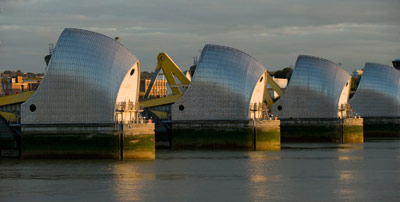
The gleaming Thames Barrier protects London from flooding
London has long been vulnerable to flooding: in 1236 the Thames rose so high that people were able to go boating across Westminster Hall, now part of the Houses of Parliament. But with sea levels inching upwards and tectonic movements tilting the south of England slowly into the sea, something had to be done. The crunch year was 1953, when more than 300 people drowned in floods around the Thames Estuary.
The 520-m- (1,706-ft-) long Thames Barrier became operational in 1982, adding a futuristic new landmark to the riverscape in the form of its seven curvy piers, which line up like shiny steel shark fins advancing on London. The barrier is effectively a tilting dam, swinging up from the riverbed in 10 circular sections whenever surge tides threaten.
The visitor experience is divided by the river. An information centre on the south bank has working models of the barrier in action. To the north, the Thames Barrier Park is a curious landscape of shaped hedgerows, honeysuckle and aerial walkways, perfect for hide-and-seek. Both sides of the river have cafés, playgrounds, and scintillating views, but in summer, the fountain plaza tempts most families northwards with its 32 jets of splashing fun.
Kids’ Corner
Number crunch
The Thames Barrier in numbers:
- £520 million – the original building cost
- 3,300 – tonnes of steel in each gate
- 10 – the number of minutes it takes to raise each gate
- 119 – the times the barrier has been raised to prevent flooding since 1982
- 350,000 – London homes saved from getting very watery
Flood warning!
How long will the Thames Barrier continue to protect London? Scientists reckon at least another 50 years, but nobody knows for sure. If the barrier failed during a tidal surge, the city would be 2 m (6 ft) deep in water within an hour. You can see how London would look after a flood at
www.postcardsfromthefuture.co.uk. Why not draw your own imagined view of your favourite London landmark submerged in water?
< Beyond the City Centre
V&A Museum of Childhood and Around

Fashion dolls on display at the V&A Museum of Childhood
The Cinderella borough of Hackney is finally having a ball, as young professionals move in prompting the opening of hip shopping and dining venues. Especially vibrant are London Fields, home to a lido, and über-trendy Broadway Market. Families will love the V&A Museum of Childhood in nearby Bethnal Green, offering a full day of play for free – and the Central line brings visitors virtually to the door. Visit on the first Sunday of the month, when the Ragged School Museum, one Tube stop further, stages Victorian lessons.
1. V&A Museum of Childhood
2. Geffrye Museum
3. Hackney City Farm
4. Hackney Museum
5. Sutton House
6. Discover
7. Ragged School Museum
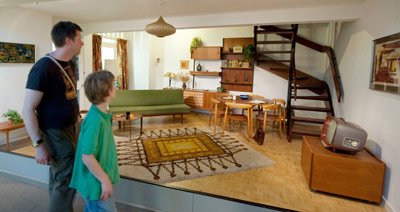
The mid-20th-century room at the Geffrye Museum
1. V&A Museum of Childhood
The grandest playroom in London

Classic Barbie with matching luggage
Children want to play with toys, not just look at them, and that’s tricky when the toys include a queen’s doll’s house, an 18th-century puppet theatre and the very first Mickey Mouse doll. The Museum of Childhood solves the problem by creating “activity stations” between its display cases, where kids can ride a rocking horse, jump in a sandpit or put together a robot. The impressive building – a huge Victorian pavilion with plenty of space and pink iron balconies – helps set the tone.
Key Features
1. Queen Mary’s Doll’s House Part of a large collection, this was furnished personally by Queen Mary. Look for the tiny telephone – ultra-modern in 1910!
2. Vintage pedal car A perfect replica of an open tourer, this has working lights, a horn and a turning starter handle. It would have cost a fortune in the 1920s.
3. Game Boy Hand-held games took off in 1989 with the Nintendo Game Boy, which sold 118 million. The Moving Toys gallery looksat toy technology from zoetropes onwards.
4. Dolls This collection of over 4,000 dolls dates back to 1300 BC and includes well-known favourites such as Cabbage Patch Kids, Barbie and Tiny Tears.
5. Venetian Puppet Theatre This huge 18th-century theatre provided entertainment for an aristocratic Venetian family.
6. Victorian seaside This gallery has a sandpit for toddlers, overlooked by a 100-year-old Punch & Judy theatre and a booth for kids to stage their own shows.
7. Construction Toys Meccano, Lego and Mr Potato Head all feature in this impressive collection of 20th-century construction kits.
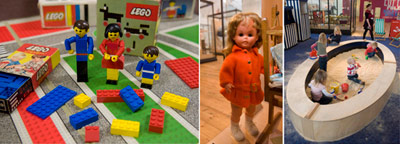
Left
Colourful early Lego Middle Tiny tears doll Right Sandpit in the Victorian seaside gallery
Kids’ Corner
True or false?
- The yo-yo was first used as a weapon. In the Philippines, tribesmen tied stones to spools of string and fired them out of trees to kill prey.
- Ludo was first played in India 1,500 years ago. Emperors used a giant board – and their servant girls as the counters.
- The Frisbee was invented by American students who threw empty pie tins stamped with the name Frisbie Baking Company.
Mime time
Find these toys, and see if you can act just like them:
- A robot. Can you march like one?
- A jack-in-the-box. Can you spring up like one?
- A marionette. Can you dance like you’re on strings?
Ask a grown-up to score you out of 10.
Family favourites
See if you can track down old toys featuring the Mr Men, Noddy, Postman Pat, Mickey Mouse and Batman. Which of these do you think your mum or dad knew when they were children? What about your grandparents?
Trick a grown-up!
Catch out an adult with this quiz question. Which country first made dolls like this?
Did they say Russia? Wrong! The idea was borrowed by Russian toymakers from Japanese dolls.
2. Geffrye Museum
The ghosts of London past
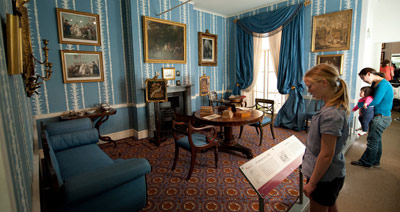
An elegant drawing room at the Geffrye Museum
On paper, it sounds like a bizarre choice for a family day out in London: a procession of roped-off living rooms revealing how carpets, sideboards and wallpaper have evolved from 1600 to the present day. But the Geffrye Museum has one of the hardest-working children’s programmes anywhere, from its monthly Saturday Specials with activities such as portrait painting, spider handling and animation workshops, to its five-week Christmas Past season, when the halls are well and truly decked with historical holly. Family audio guides, quiz trails and activity packs are available every weekend, and there’s a refreshing commitment to all age groups, from toddlers to teens. Choose a day when there is lots happening, tell the kids they’re going to be travelling back in time to Tudor England, and they’ll be gripped.
The museum is set in a cute quadrangle of 18th-century almshouses, its front pathway lit by ghostly furniture, the work of installation artist Kei Ito. Indoors, 11 set-dressed rooms chart the changing face of middle-class décor, from a 1630 merchant’s parlour to a 1998 loft apartment. From April till October, the museum’s immaculate period gardens host picnic parties, steel bands and other festivities.
Kids’ Corner
Time-travel challenge
Exploring the Geffrye Museum is a bit like being a time-traveller. Can you spot these three objects?
- A polar bear
- Some birds under glass
- A clay bottle with a face on it.
See if you can include all three in an adventure story about a child who journeys back to the past. Or look for Sam the dog in the Victorian time-travel game on the museum’s website:
www.geffrye-museum.org.uk/kidszone.
Room of the future
Which of the rooms at the Geffrye Museum would you like to live in? Maybe you’d prefer life in the future? What would a room from the year 2050 look like? Draw a picture of it when you get home.
3. Hackney City Farm
Meet Larry the showbiz donkey
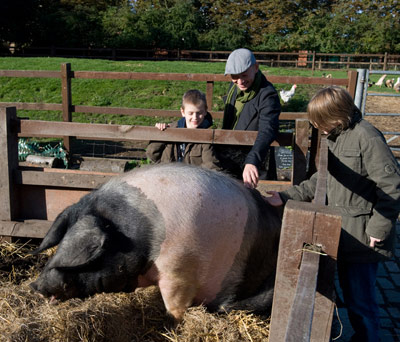
Bella, a British saddleback pig, at the Hackney City Farm
One field does not a farm make, but hats off to the enterprising band of locals who transformed this postage stamp-sized piece of land in one of London’s most congested boroughs. Created in 1984 on the site of a derelict lorry park, the farm now has calves, goats, sheep, pigs, rabbits, geese and chickens (not forgetting Larry the donkey, star of the small screen), plus a thriving crafts studio and a cottage garden growing seasonal vegetables.
Feeding time is at 4pm and there’s a clutch of courses for all ages, from felt-making and yoga to beekeeping and green living, plus regular afternoon pottery sessions for children. It’s worth visiting just for lunch at the sparkling Frizzante café, whose zesty Italian food has made it a dining destination in its own right.
Kids’ Corner
Dare you to eat it!
After exploring the pie-and-mash shop at Hackney Museum, head down to nearby Broadway Market. There you’ll find F. Cooke’s, where East Enders have been eating this traditional London dish since 1900. The dish consists of a minced-beef pie with a scoop of mashed potato. Watch out for the bright green “liquor” that’s poured over the top, made by adding parsley to the water used to boil eels.
4. Hackney Museum
The world on your doorstep
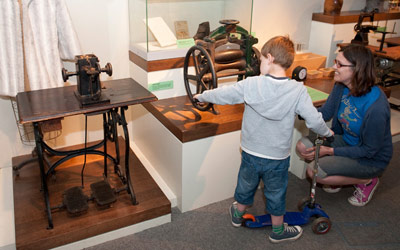
Hands-on exhibits captivate at the Hackney Museum
Hackney promises to be the hippest place in London, thanks to its rich stew of cultural influences, and this bright and breezy local museum does a tasty job of stirring the pot, especially for families, though it might be a bit unsafe in the evening. The overarching theme of the museum is the 1,000-year history of people who have settled here, and the touchy-feely tone begins with the very first exhibit – a replica Saxon boat that kids can load up with goods. Elsewhere, they get to step into an East End pie-and-mash shop, play conductor on a vintage London bus, and race against the clock to make matchboxes – just as hundreds of poverty-stricken children did in 19th-century Hackney. There are drop-in dance, storytelling and art workshops in school holidays, often coinciding with a temporary show – the summer exhibition is always a hive of hands-on interactivity.
If it’s sunny, combine a snoop around the museum with a splash at London Fields Lido, a short walk away via Richmond Road. Open every day, this is the city’s only Olympic-size heated outdoor pool.
Kids’ Corner
Eeyore!
How do donkeys bray? The “eeee” sound comes from a deep intake of breath and the “ore” is made when they breathe out again through their nose. Try it yourself!
5. Sutton House
A Tudor manor in 21st-century London
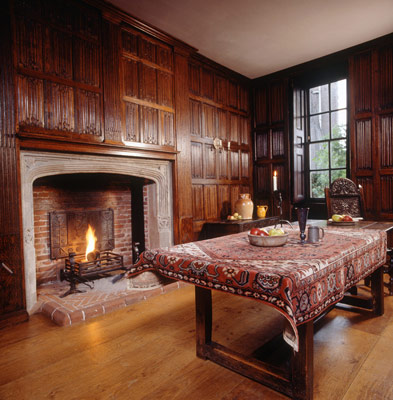
Atmospheric 16th-century room at Sutton House
Oak panelling, echoing flagstones, roaring fires… Sutton House couldn’t look more Tudor if Henry VIII himself was at the banqueting table, tossing chicken legs over his shoulder. Built in 1535 by Sir Ralph Sadler, Henry’s Secretary of State, it’s the last relic of the once-rural Hackney village.
There is plenty to engage kids, including the 16th-century kitchen, with food to handle and smells to sniff, and three “treasure chests” full of hands-on historical goodies – they include Elizabethan codes to crack, Jacobean jigsaws, and even a “dance mat” on which to perfect your 17th-century moves. The Sutton House stewards are ever ready to share a spine-tingling ghost story, while the mechanic’s yard is being transformed into an imaginative outdoor play space, with an old Hackney cab and ice-cream van. Admission is cheap by National Trust standards, and free altogether on the last Sunday of the month, when there’s a family day themed on music or meals, spooks or squatters (a room of “squatter art” has been preserved from the 1980s). In the summer holidays, there might even be a jousting tournament in the courtyard.
Kids’ Corner
Whoooof!
Sutton House is said to be haunted. Three ghostly hounds have been heard howling in the dead of night. Keep a close watch for them in the nursery (clue: look somewhere warm).
Pooo!
Sutton House has one of London’s oldest toilets – a 16th-century “garderobe”. Garderobe literally means “a place to keep clothes” The Tudors thought the stink would keep cloth-nibbling moths away!
6. Discover
A stroll in storyland
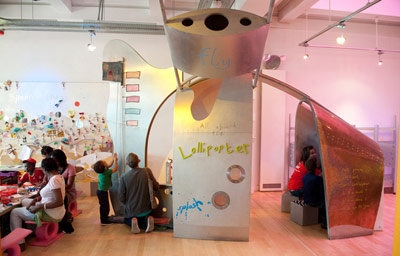
Getting hands-on and stirring imaginations at the Discover Centre
Shock! Crisis! Emergency! The planet Squiggly Diggly is running out of stories, and a friendly alien named Hootah has been sent to Earth to gather some. That’s the backstory for the Discover Children’s Story Centre, a one-of-a-kind walk-through wonderland of enchanted towers, secret caves and wishing trees, with lashings of dressing-up and acting-out to help ensure a happy ending.
On the Story Trail, children wander wide-eyed among £6 million-worth of multi-sensory play gear designed to spark the imagination: they might bump into a giant, dress up as a princess, sit down for a tea party, or make a spoon puppet and put on a show. Friendly “story builders” are on hand to help them compose their own tall tales; and in case they can’t quite believe it themselves, a bank of TV screens shows their progress in storyland.
There is more make-believe in the Story Garden outside, with its pirate ship, space craft, trick mirrors and giant musical instruments; while interactive shows in the Story Studio profile popular kids’ characters. Weekend storytelling sessions culminate in the Big Write festival each March, which throngs with well-known writers and illustrators.
Kids’ Corner
Name that book
Here are some of the writers and illustrators who have visited the Discover Centre. Can you name the characters they created?
-
Nick Butterworth created this park keeper and his friends, the badger and the fox.
-
Lauren Child wrote about this cheeky little girl and her patient older brother.
-
Axel Scheffler drew this woodland monster who befriends a brave mouse.
7. Ragged School Museum
Back to school, Victorian style
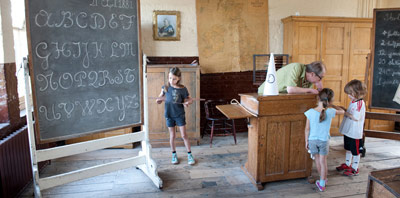
Learning the Victorian way at the Ragged School Museum
In Victorian London, children didn’t just do without toys and books, they often lacked shoes and a shirt. More than half were illiterate, and one in three funerals were for children under five. A young Dubliner, Thomas Barnardo, was so shocked by the poverty he saw in the East End, he set about rescuing orphans and setting up “ragged schools” to educate them – including this one, in a canalside warehouse in Mile End.
Today, a Victorian education is delivered here again by strict-but-fair Miss Perkins, in full 1870s garb, who scratches the alphabet on her blackboard for pupils aged five to 85. The monthly lessons are a real eye-opener for kids – especially those with poor handwriting, who may end up standing in the corner wearing a dunce’s hat.
The school has also re-created an East End kitchen from 1900, with a mangle, a tin bath and other hands-on hardware. Top marks for interactivity, but the museum must do better on opening times.
Kids’ Corner
Hard times
In Victorian times, many children went out to work at age five. Lots of parents didn’t send their kids to school – they needed them to earn money instead. One ragged school teacher even gave out baked potatoes so the children would turn up!
< Beyond the City Centre
Kenwood House and Around
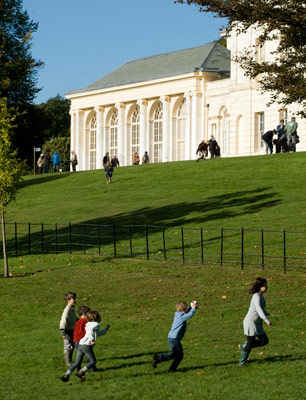
Playing on the landscaped lawns around Georgian Kenwood House
Aside from its Georgian mansion, Kenwood House, this locale is light on visitor attractions. But there’s one compelling reason to make the train ride north: Hampstead Heath, a world of playgrounds, pools and woodland. Kenwood combines well with Golders Hill Park and lunch at The Spaniards Inn (Northern Line to Golders Green, then bus number 210). Or alight at Hampstead, pick up a picnic and hike to the Heath. Consider, too, a visit to Wembley Stadium (Jubilee Line) or the RAF Museum (Northern Line), a little further out of town.
1. Kenwood House
2. Warner Bros. Studio Tour London – The Making of Harry Potter
3. RAF Museum
4. Wembley Stadium
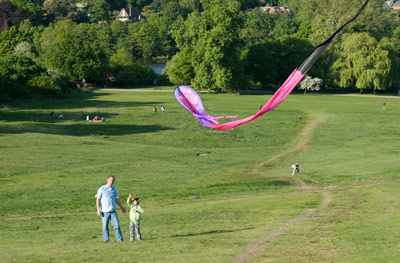
Kite-flying on Parliament Hill, Hampstead Heath
1. Kenwood House
The big house on the Heath
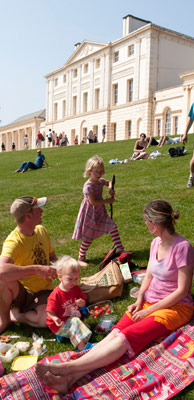
Picnicking outside Kenwood House
With its manicured lawns, ornamental lakes, stables and kitchen garden, Kenwood is a gentleman’s country estate, 6 km (4 miles) from London’s West End. It’s an authentic slice of Georgian England, where Robert Adam’s Neo-Classical interiors and Humphrey Repton’s picturesque park survive more or less intact from the late 1700s. Immediately to the south stretches Hampstead Heath, a hinterland frequented by wild swimmers, kite-fliers, Frisbee-throwers and tree-climbers. It is a big blast of freedom for families.
Key Features
3. The library, with its ostentatious painted ceiling, colourful friezes and colonnades, is one of Robert Adam's masterpieces.
• Picnic concerts are staged in Kenwood’s grounds on Saturday evenings in summer. In recent years the bill has featured Blondie and music by Vivaldi, usually with a fireworks finale.
• Rembrandt self-portrait (1661) This picture is a highlight of Kenwood’s collection of old masters, which also includes Vermeer’s The Guitar Player and paintings by Hals, Turner and Gainsborough.
• The park was remodelled in the 1790s under the guidance of Humphrey Repton. Its meandering lakeside walks are designed to spring picturesque “surprises”.

Left
The library Middle Rembrandt self-portrait (1661) Right The park
Kids’ Corner
Legends of the Heath
Here are three famous legends about Hampstead Heath. Do you think they’re true or false?
- Boudicca, the warrior queen who fought against the Romans, is buried in the mound near the bathing ponds.
- Parliament Hill got its name because the Gunpowder Plotters gathered there in the hope of seeing the Houses of Parliament go up in flames.
- The highwayman Dick Turpin hid out at Spaniards Inn, watching the London road for carriages to rob.

On guard!
In Georgian times, gentlemen frequently fought duels to decide arguments – often with deadly results. During the reign of King George III, more than 170 duels took place on duelling grounds like the one at Kenwood House. The combatants would meet at an agreed time, choose pistols, stand back to back, stride 20 paces, turn and fire.
You could try this today, using sponge balls. You have to stay still while the other person throws the ball at you. But don’t forget to shout some 200-year-old insults, like “Have at you!” and “On guard, you dog!”
2. Warner Bros. Studio Tour London – The Making of Harry Potter
A simply wizard tour!
Here at Warner’s studio, even though there are no thrilling rides and only a few hands-on interactive gadgetry, children will be spellbound by the original scenery, costumes and props that were used in the filming of all eight Harry Potter movies.
The Making of Harry Potter studio tour is by timed ticket and is largely self-guided, though friendly and knowledgeable staff are always on hand. Among the sets en route are the iconic Great Hall at Hogwarts School of Witchcraft and Wizardry, Professor Dumbledore’s study, Hagrid’s hut, the Gryffindor common room and Diagon Alley, complete with Ollivanders wand shop and the Weasley brothers’ joke emporium. Hagrid’s motorcycle and Harry’s Nimbus 2000 are also on display.
Kids will be delighted to know that they can ride broomsticks here as well. The tour also offers glimpses into the off-camera world of the film-makers, including how animatronics and green-screen effects brought the monsters and marvels of Harry’s world to life.
3. RAF Museum
Fighter pilot playtime
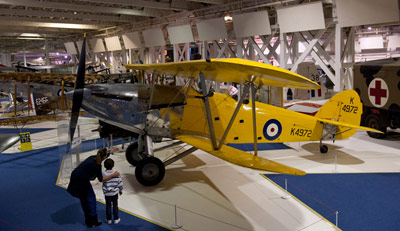
Getting up close to one of the many planes on display at the RAF Museum
Many kids want to be a fighter pilot when they grow up. Few actually make it, so here’s the next best thing: a whole hangar full of interactive flying games and challenges at the Royal Air Force Museum in Hendon. Its Aeronauts Centre has 40 hands-on experiments that cunningly disguise principles of science as play: climb into a helicopter cockpit and take the controls; grab a hang-glider bar and manoeuvre through the air; or grapple with pilot aptitude tests. The museum is spread across the former Hendon Aerodrome, the century-old birthplace of British aviation. Giant hangars house more than 100 full-size flying machines, from Sopwith Camels to cruise missiles, many suspended dogfight-style from the rafters. The Milestones of Flight gallery gives a literal overview of aircraft history from its “control tower” balcony, and other highlights include a sound and light show – Our Finest Hour – bringing alive the Battle of Britain, a “4-D” theatre experience aboard an American B-17 bomber, and a Eurofighter Typhoon flight simulator, soaring at twice the speed of sound.
Kids’ Corner
Handmade Hogwarts
Keep an eye out for the amazing scale model of Hogwarts, which was created by an army of 86 artists. Had it been built by one person, it would have taken 74 years to complete! It is 24 times smaller than the real thing and was used in aerial shots for the films. See if you can spot...
- 2,500 tiny torches and lanterns flickering on and off inside
- Real plants
- Tiny model birds in the owlery
- Real hinges on every door
Is it a bird?
The RAF Museum’s aircraft have all sorts of names. As you explore, score points for spotting…
- Names inspired by the wind or the weather
- Names borrowed from birds and animals.
4. Wembley Stadium
Ninety minutes of glory

Going behind the scenes at Wembley Stadium
After a controversial £750 million rebuilding, the “new” Wembley Stadium has resumed its mantle as the spiritual home of football, with 90,000 seats and a 133-m (436-ft) arch that curves like a rainbow above the North London skyline. As well as the FA Cup final each May, Wembley hosts international rugby, American football, rock concerts and the 2012 Olympic football finals.
For footie-mad kids (and adults), a trip here is akin to a pilgrimage, and the 90-minute guided tours won’t let them down. They get to follow in the footsteps of their heroes on matchday – from the England team’s dressing-room and warm-up area, through the tunnel to pitch-side, where they’ll be greeted by the cacophonous roar of a piped-in crowd. After a sit down in the manager’s dugout, it’s up the famous steps to the Royal Box for a feel of a replica FA Cup. For the adults, there’s also a video of historic highlights and a look at some famous Wembley relics, including the crossbar that helped England win the 1966 World Cup.
Kids’ Corner
Wembley in numbers
-
Winning teams must climb 107 steps to collect the trophy. In the “old” Wembley, it was just 39 steps. How many more steps is that?
-
The stadium holds 90,000 fans. If there are 34,000 seats on the bottom tier and 39,000 on the top, how many people can sit in the middle tier?
-
The pitch is 105 metres long and 68 metres wide. What’s its total area?
< Beyond the City Centre
Horniman Museum and Around
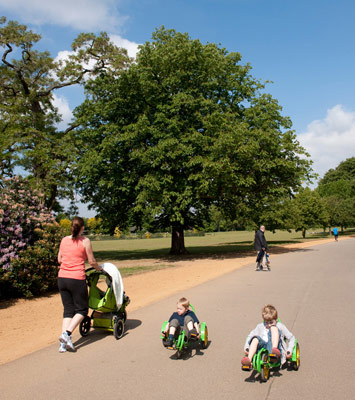
Enjoying a ride through Dulwich Park on the recumbent bicycles available for hire
If the Horniman Museum was in Central London, it would be on every family’s must-see itinerary. A treasure chest of strange marvels, it has everything from voodoo charms to mummy cases, live bees to stuffed apes and a skull-covered hat. The museum is near Forest Hill, a 15-minute train ride from London Bridge station. The P4 bus route runs from the Horniman to South London’s other star attraction: Dulwich Picture Gallery, whose old masters come to life at ArtPlay family workshops. Better still, walk there across Dulwich Park, where the Pavilion Café is a super sunny-day lunch option.
1. Horniman Museum and Gardens
2. Dulwich Picture Gallery
3. Crystal Palace Park
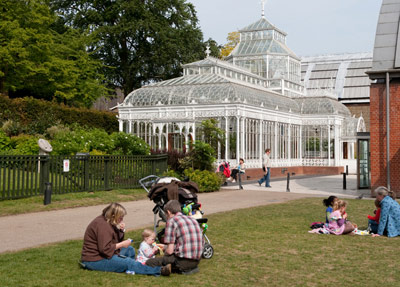
Picnicking on the lawns surrounding the ornate Victorian conservatory at the Horniman Museum
1. Horniman Museum and Gardens
Mummies, magic amulets and a merman
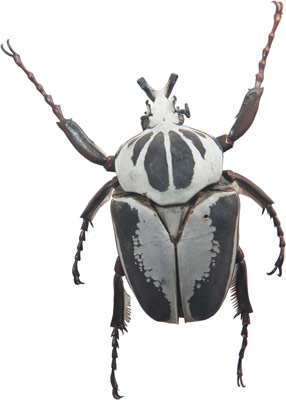
Goliath Beetle in the Nature Base
A Victorian tea trader, Frederick Horniman gathered an eclectic collection of objects from across the British Empire. His museum bursts with artefacts from the wildest childhood imagination: a totem pole, a torture chair, magic amulets, mummies, even a merman. Apart from being child-friendly, there is the universally popular Aquarium as well as exhibits that appeal to older age groups. It hosts some of London’s most exotic “Busy Bee” play sessions, which could involve sharks’ teeth, ritual masks or thumb pianos.
Key Features
1. Haitian voodoo shrine This gloriously gaudy altar is loaded with strange offerings: make-up, dolls, posters, perfume, skulls. Haitians believe spirits are everywhere, even in discarded objects.
2. Igbo Ijele mask Piled with figurines and feathers in fantastic colours, this towering mask is Africa’s largest. It is worn at the lively ijele ceremony in Nigeria.
3. Music Gallery Touch the tabletops to hear sound clips from the dazzling instruments collection.
4. Tlingit totem pole Carved in cedar, the Horniman totem pole guards the entrance. It depicts the Alaskan legend of a girl who married a bear.
5. Nature Base Here you can observe a live honey bee colony, watch the scampering harvest mice and scrutinize beetles under a microscope.
6. Aquarium The aquarium features 15 displays, from a British pond to a Fijian coral reef. For kids, the seahorses are the stars.
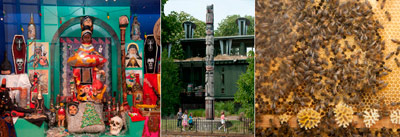
Left
Haitian voodoo shrine Middle Tlingit totem pole Right Honeybee colony
Kids’ Corner
Twang!
As the museum’s thongaphone proves, musical instruments can be made from anything. Here’s how to make a shoebox lute:
-
Take an old shoebox and carefully cut a round hole in the lid.
-
Stretch five or six rubber bands around the box, so they run across the hole. Use thick and thin ones.
-
Don’t touch!
Can you spot the poison dart frogs in the aquarium? The golden poison frog is the deadliest frog species of all, with enough toxin to kill 20,000 mice. Just touching one could kill you!
Chasing shadows
Sundials use the sun’s shadow to tell the time. How many different ones can you find in the Horniman grounds? There are 10 to find – including one that needs you to work it!
Real or fake?
Why isn’t the walrus wrinkly? Because when he was stuffed in the late 19th century, no one had seen a live walrus, so they didn’t know how full he should be. Other than being overstuffed, he’s the real thing though! Nearby you’ll see a merman – or is it? Actually it’s a combination of a fish’s body and a fierce head made from paper and clay. Now that’s REALLY creepy!
2. Dulwich Picture Gallery
Old masters and leafy grounds
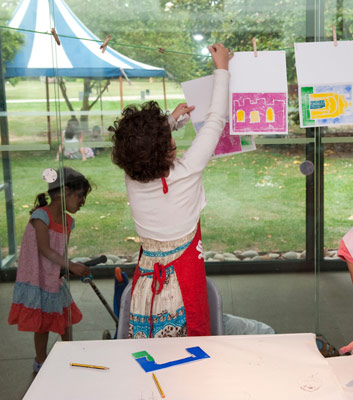
Hanging out paintings to dry at Dulwich Picture Gallery
With its cloistered gardens, chapel and mausoleum, this looks precisely the kind of place that wouldn’t welcome children, but appearances can be deceptive. London’s oldest public gallery is crammed with priceless portraits – from 17th-century saints to 18th-century courtesans – which were gathered in the 1790s for the King of Poland, who was promptly overthrown, leaving his new collection homeless. Architect
Sir John Soane stepped in, and with his interlinked halls lit by skylights, created the template for art galleries the world over. There are works by Canaletto, Constable, Raphael and Rubens here – and free drawing trails help visitors to unpick their secrets.
The real joy for families, though, is the inspiring array of hands-on art classes that are offered here. On the first and last Sundays of the month, drop-in ArtPlay sessions encourage grown-ups and their children to work creatively together – drawing cartoons, making bunting or block-printing, perhaps. There is more of the same every Wednesday afternoon in summer, when the gallery gardens are transformed into a giant arty picnic. There are also half-term workshops for ages 6–11, and after-school art clubs for 7–18s.
The 15-minute zip out of town to leafy Dulwich Village feels like a magical journey into the heart of the countryside, and once sated with old masters, children get to cross the road into attractive Dulwich Park, with its boating lake, bike hire and adventure playground.
Kids’ Corner
Stop, thief!
At Dulwich Picture Gallery, find the portrait of Jacob de Gheyn III, by Rembrandt. This is the world’s most stolen painting! In 1983 a cat burglar lowered himself through a skylight and spirited it away. Where do you think the police finally found it?
-
a Tied to a bicycle
-
b Under a graveyard bench
-
c In a train station luggage rack
3. Crystal Palace Park
The land that time forgot
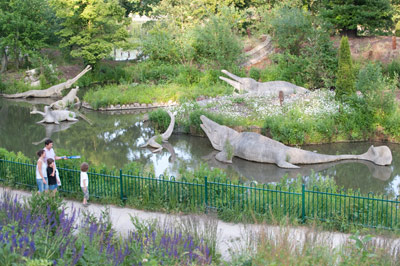
Dinosaur-spotting in the Dinosaur Park at Crystal Palace Park
Television, theme parks and the Girl Guides – a fine trio of inventions, especially if you happen to be a child, and all were hatched here in one of London’s most history-packed parks. So it’s great that Crystal Palace is finally getting a new lease of life after years in the doldrums, with plans afoot for a multi-million pound makeover that will restore it to something like the popular pomp of its Victorian heyday.
The park was created by master gardener Joseph Paxton (1803–65) to house his mammoth Crystal Palace, which was moved here pane by pane from Hyde Park after hosting the 1851 Great Exhibition. Perched on a ridge overlooking the city, it had extensive pleasure grounds and fountains higher than Nelson’s Column, and thousands flocked to visit. However, the Crystal Palace burnt down in 1936: look out for its ghostly terraces, and the odd statue of a sultan or sphinx. But one of the park’s original wonders is still a huge draw for families – its Dinosaur Court, an army of 30 life-size prehistoric monsters that stalk the boating lake. Installed in 1853 by the sculptor Benjamin Waterhouse Hawkins and the pioneering palaeontologist Richard Owen, these models were a sensation in their day, prefiguring Darwin’s Origin of the Species and staking a claim for Crystal Palace as the world’s first “theme park”.
Pick up a guide from the park information centre and go hunting for iguanodons and pterodactyls – dino-mad kids will enjoy pointing out the anatomical errors exposed by 150 years of science. The nearby children’s playground boasts a dinosaur climbing frame, and the park also has a small farmyard with alpacas and a reptile room, plus one of the biggest hedge mazes in the country. Add the indoor facilities at the sports centre, the spiritual home of British athletics, and there’s easily enough to warrant a train ride out from the city centre. Soon, there should be more entertainment, too – the Crystal Palace masterplan promises tropical glasshouses, a treetop walkway, even a revival for one of Paxton’s 1850s fountains.
Kids’ Corner
Eureka!
Three great ideas that started in Crystal Palace Park…
1) Theme parks
Crystal Palace had the world’s first dinosaur sculptures – Victorian visitors flocked to walk among them, and bought small models as souvenirs. Look out for the iguanodon – in 1853, the Dinosaur Court opened with a grand dinner served inside its belly!
2) Television
John Logie Baird, who invented television, beamed the first television shows from his Crystal Palace studio in 1935. You can’t miss the giant TV mast that still stands here – at 219 m (719 ft) it’s the fourth tallest thing in London.
3) Girl Guides
The Guides started here in 1909, when a group of girls marched on a Boy Scout rally and demanded to join. See if you can find the Guide badges hidden inside the park’s hedge maze.
< Beyond the City Centre
Kew Gardens and Around
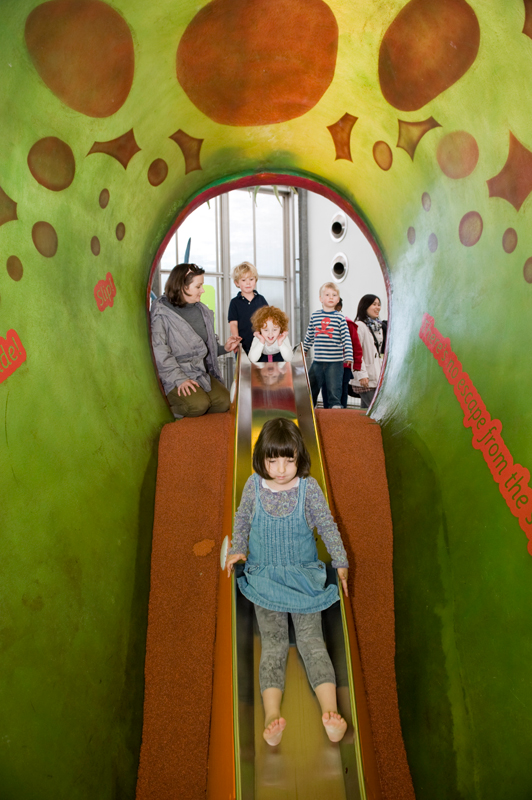
Interactive play area, Climbers and Creepers, at Kew Gardens
Glossy, well-groomed and handily located at the end of the District line, Richmond and Kew offer a breath of fresh air for families overcome by the pace of the city. Kids will delight in the gardens’ attractions and they will love Richmond Park – especially its deer. For Kew, alight at the tube station, pick up a picnic and tour the gardens on the Explorer Bus. For Richmond Park, take bus number 65 or 371 from Richmond station. Several stately homes are close, too: try the riverside walk from Richmond to haunted Ham House.
1. Kew Gardens
2. WWT London Wetland Centre
3. Syon House
4. Osterley Park
5. Richmond Park
6. Ham House
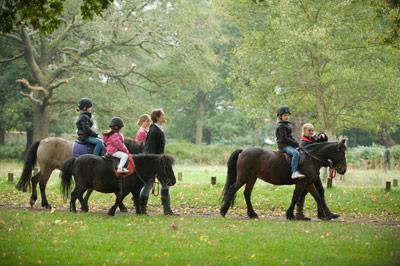
Youngsters riding ponies through Richmond Park
1. Kew Gardens
The world’s most famous garden
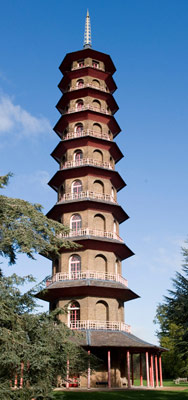
Oriental Pagoda
Founded more than 250 years ago, the Royal Botanic Gardens – a treasure trove of lakes, mini-temples, nature trails and playgrounds – is a delightful place to spend time. Kew’s Victorian glasshouses offer a botanical world tour, but even better is just dawdling in the dappled glades around Queen Charlotte’s Cottage, or admiring the peacocks at the Waterlily Pond. Little visitors can burrow in a badger sett and climb into the treetops – and if that doesn’t tire them out, there’s an exhilarating plant-themed playhouse.
Key Features
1. Treetop Walkway Clamber into the branches of Kew’s arboretum for giddying views. The walkway is designed to sway in the wind.
2. Palm House The tropical plants here drip in the steamy atmosphere of Kew’s hottest glasshouse. In the basement aquarium, don 3-D glasses and go “swimming with plankton”.
3. Temperate House The world’s biggest Victorian glasshouse is also home to the world’s tallest “house plant”, reached via ornate iron balconies.
4. Climbers and Creepers Fall prey to the slippery pitcher plant or wriggle into a field-mouse nest in this ingenious indoor playground. Outside, the Treehouse Towers has a zipwire and rope bridges.
5. Evolution House Waterfalls crash and insects hum on this trip through primordial swamps back to the age of the dinosaurs. Watch out for monster millipedes!
6. Princess of Wales Conservatory Look out for Venus flytraps and the world’s largest flower in one of 10 climatic zones. Portholes give a close-up view of the fishponds.
7. Badger Sett Expect muddy kneecaps after a crawl inside this child-size badgers’ home. Nearby, the Nature Hide and Stag Beetle Loggery explore more native wildlife.

Left
Treetop walkway Middle Badger sett Right Princess of Wales conservatory
Kids’ Corner
World beaters!
Can you track down these record-breaking plants in Kew’s glasshouses, and name them?
-
The world’s tallest indoor plant
-
The world’s oldest pot plant
-
The world’s heaviest seed.
Flower power
The Palm House has lots of amazing medicinal plants. Look for the Madagascan periwinkle – its sap is used to treat leukaemia, a disease that once killed 80 per cent of children who contracted it. Now more than 90 per cent have a good chance of surviving.
Nature detective
How many badgers can you find in the crawl-through sett? There are about 20 real ones living at Kew, but they’re very secretive by day. Try to spot these telltale signs of badger activity:
- Scratched trees – to sharpen claws to dig for worms
- Well-trodden pathways – they always follow the same routes
- Black-and-white hairs – tufts of fur catch on fences.
What a stink!
Heard about the flower than smells like a dead animal? It’s called the titan arum, nicknamed the “corpse flower”, and it’s the world’s largest, growing up to 3 m (10 ft) tall. When Kew’s titan arum flowered in 1926, so many people came to see it that the police had to be called to control the crowds!
2. WWT London Wetland Centre
London’s best duck pond
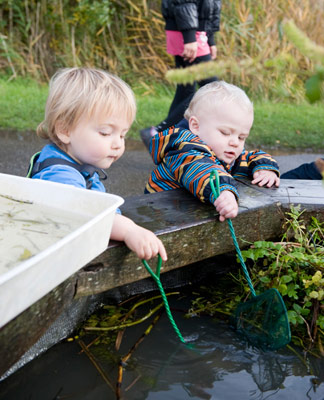
Little dippers looking for waterborne wildlife at the London Wetland Centre
Opened in 2000, London Wetland Centre has been a conservation triumph – an ugly-duckling reservoir site transformed into a beautiful wilderness of lagoons and pasture just 6 km (4 miles) from Westminster. Thousands of waterbirds live here, including exotic duck species such as grey-and-gold feathered wigeons, which graze the fields like sheep; and shovelers, which swim in manic circles to create a vortex to bring their food to the surface.
The indoor Discovery Centre is all about engaging children, with its underwater pond camera and poo-shooting exhibit, demonstrating how reed beds filter dirty water. The all-action adventure playground has frogs to bounce on and rubber ducks to race, and kids can wander out into the wetlands to watch for water voles and admire the reserve’s eco-friendly lawnmowers – a trio of cute frizzy-wigged highland cattle. There is warden-led bird feeding each afternoon, while the family events programme fills every weekend and school holiday with nestbox-building, pond safaris and (at Easter) egg candling – a fascinating glimpse inside a duck egg as it develops. But what young ones will appreciate most, perhaps, is the immense feeling of space, and the glorious London skyline stretched across a far horizon.
Kids’ Corner
Yum!
Match these Wetland Centre residents with their strange eating habits.
-
If food is scarce, this creature’s babies sometimes gobble up younger brothers and sisters.
-
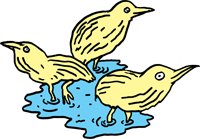
This creature can catch and eat 3,000 insects in a single night!
-
Mostly vegetarian, this creature sometimes snacks on frogs’ legs when food is scarce.
3. Syon House
Costume drama heaven
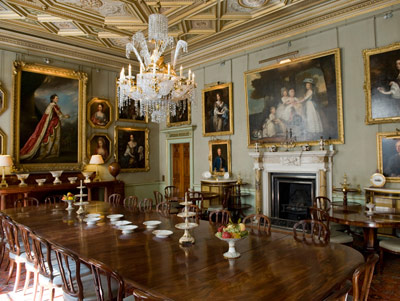
The Neo-Classical Northumberland family dining room at Syon House
Gleaming like a gold ingot beside the Thames, this is outer London’s last bastion of aristocratic England – still home to the Dukes of Northumberland after more than 400 years. It’s easy to imagine the house as a stage set, and on the big screen it has starred in both Gosford Park and The Madness of King George. Meanwhile, its stellar cast of real-life characters includes Henry VIII and Sir Walter Raleigh, Indian chiefs and Gunpowder Plotters.
Explore the epic suite of rooms designed for the first duke by Robert Adam (1728–92), who gave him the gilded gods, silk hangings and wedding-cake ceilings he had seen in Neo-Classical Italy. There is also the domed Great Conservatory – so grand it inspired Joseph Paxton’s
Crystal Palace – and the extensive grounds modelled by “Capability” Brown (1716–83). For kids, the ornamental arboretum is especially bewitching during Syon’s “Enchanted Woodland” season, when it twinkles with more than 1,000 lights. Younger children can be humoured with the promise of a romp at Snakes and Ladders, a soft-play centre in the grounds.
Kids’ Corner
Syon’s sovereigns
These Tudor monarchs all spent time at Syon House, and all came to sticky ends. Can you name them?
-
This king had six wives. In 1547 his coffin was brought to Syon, where it split open during the night. Dogs were found licking up what leaked out!
-
This queen was held at Syon by Henry VIII in 1542, then taken to the Tower and beheaded.
-
This Queen was offered the throne at Syon in 1553, when she was 16. She reigned for just nine days, and eventually lost her head.
4. Osterley Park
A very big banker’s bonus
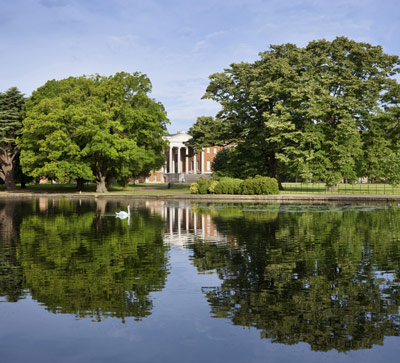
The magnificent mansion at Osterley Park, seen from across the Garden Lake
In 1761, when wealthy banker Sir Francis Child wanted a flashy new look for his family pile at Osterley Park, there was only one man to call – the style guru extraordinaire, Robert Adam. He didn’t just add a Roman portico, stuccoed stairways and the 40-m (131-ft) Long Gallery to the Elizabethan mansion, he designed new carpets, new furniture, fireplaces and ceilings. The result is a “palace of palaces”, a glimpse of how Britain’s super-rich bankers lived 250 years ago.
What’s great for children is that the rooms “below stairs” at Osterley remain pretty intact, too: in the vaulted servants’ hall, they can get to grips with antique kitchen gear, don servants’ mob caps and aprons, and watch spooky film projections of Georgian maids and footmen at work. A hand-held audio-visual guide just for kids stars Tweeny the serving girl, who leads the way from room to room, filling fireplaces and fetching water. Osterley’s panoramic parkland is open daily all year round – but aim to visit on one of the monthly family discovery days, when it’s busy with history trails, crafts and stories.
Kids’ Corner
Tweeny time
A “tweeny” was a serving girl who worked “between” upstairs and downstairs, helping both the cook and the parlour maid. They worked from 7am–11pm every day except Sundays, and got one week’s holiday per year. Victorian tweenies earned about 6 shillings a week – that’s 72p!
5. Richmond Park
Hills, hinds and Henry VIII
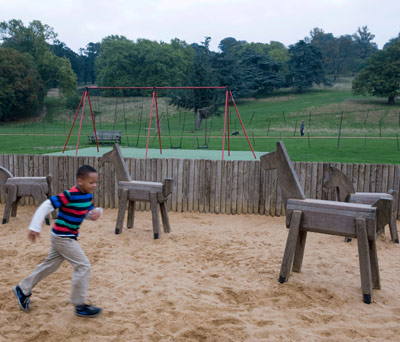
Children’s playground near Petersham Gate, Richmond Park
Gibbet Wood, Bone Copse, Leg of Mutton Pond… the names of the natural features in this park are rich with romance and they describe the place well: it is the wildest tract of country in London. Richmond is the largest royal park and remains much the same as when Charles I put a 13-km (8-mile) wall around it in 1637 and 2,000 deer were released for him to hunt. Some of the oak trees the king knew are here still, and so are the deer: 650 reds and fallows, a great draw for children – though it’s best not to get too close, especially during the autumn rut, when they spar for supremacy.
The best way in for families is from Richmond, for the playground at Petersham Gate and Pembroke Lodge Café, set in a Georgian mansion. Walk off the cakes with a hike up Henry VIII’s Mound to take in the view to St Paul’s Cathedral: some say the king stood watch here for the signal that his marriage to Anne Boleyn had been terminally severed.
There is year-round cycle hire inside Roehampton Gate, on the east side, and the park’s other sporting options include power-kiting, horse riding and fishing in Pen Ponds. Isabella Plantation, with its azaleas and maze of streams and bridges, looks sensational in spring and autumn, and the hide-and-seek potential goes on for miles.
Kids’ Corner
Trick a grown-up!
Try this sneaky riddle:
I am one of Richmond Park’s most endangered creatures. I lock horns with my rivals to win the best mates. I’m so special that the park has been made a conservation area. My name begins with “S”. What am I…?
Did they answer “stag”? Wrong! The answer is stag beetle. These fierce-looking mini-beasts are Britain’s biggest land insects. But don’t worry: they may have big jaws, but they’re not dangerous!
6. Ham House
The most haunted house in London?
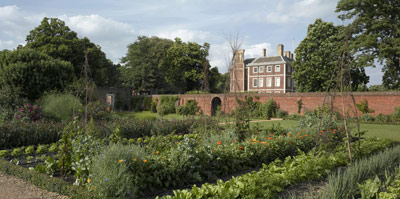
The beautifully kept kitchen garden at Ham House
With its riverside gardens, children’s treasure map and gaggle of ghosts, it’s hard to think of a more appetizing stately home for families than Ham House. The main draw is its dreamy setting, with lawns running down to an especially bucolic stretch of the Thames. The house itself is a time capsule, little changed since the 1670s, when the ruthless and beautiful Duchess of Lauderdale schemed her way to the top of Stuart society. A prime mover in the secret Sealed Knot society, which restored Charles II to the throne, the duchess filled Ham’s halls with exuberant furniture and art.
What will interest kids, though, is not the duchess’s legacy, but the fact she may still be in residence. Staff and visitors sometimes hear the tap-tap-tap of her silver cane and glimpse her King Charles spaniel scampering along the corridors. Regular ghost tours complement an imaginative spread of children’s stuff here: a dedicated Discovery Room, complete with treasure map for investigating the house; garden trails; and al fresco storytelling, cinema and theatre every summer.
On sunny days, walk to Ham from Richmond station along the Thames Path (download the route at
www.nationaltrust.org.uk/hamhouse) or hop on the historic foot-ferry across to the north bank, where Marble Hill House (Richmond Rd, Twickenham, TW1 2NL; 020 8892 5115;
www.english-heritage.org.uk) shimmers like a mirage above the water. A masterpiece Palladian mansion, Marble Hill has a weekend programme for families.
Kids’ Corner
Thwack!
Imagine getting whipped every time your friend is naughty! In 1600, people believed that young princes were chosen by God, so they couldn’t be punished for bad behaviour. Instead, a friend took the beatings in their place – the prince’s “whipping boy”.
King Charles I’s whipping boy was William Murray – Charles later made him the Earl of Dysart, and master of Ham House. Do you think it was worth it?
Art challenge
The Green Closet at Ham House is hung with nearly 90 miniature paintings, just as it was 240 years ago. See if you can be the first to find…
-
A man who’s on fire
-
A tiny picture of Ham House
-
A head on a plate.


